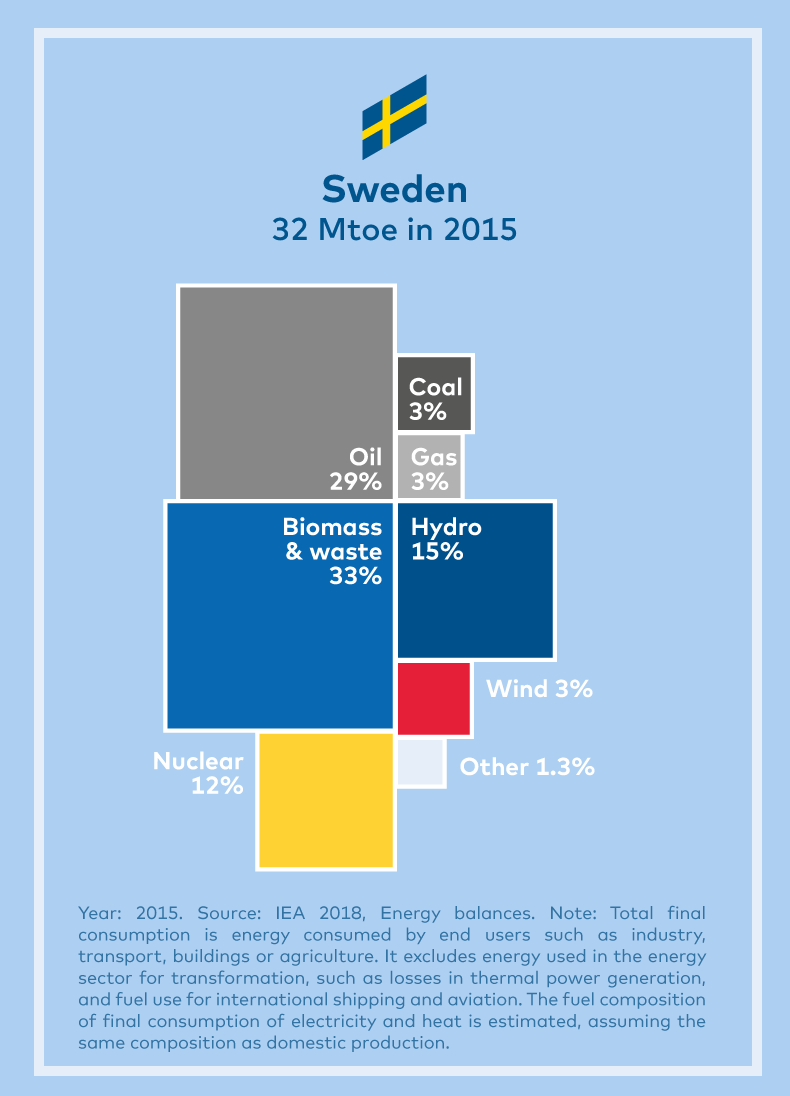Indicators
Visualising energy in the Nordic region
The Nordic Way is a growing collection of energy indicators for the five Nordic countries. Browse by topic using the menu to the right, or take a look at the recent additions below. All content is free for download.

Variable renewable energy increasing
Wind power generation has been significantly increasing since the mid-90s, bringing total Nordic wind power generation to 40 TWh in 2018 – over half of the CNS target for 2030 of 75 TWh. Solar power has also seen a rapid expansion. The power generated from solar has already surpassed the CNS 2030 target of 1 TWh. Electricity generation from geothermal energy has stabilised at just above 6 TWh, topping the CNS requirement for 2050. The use of hydropower for electricity…

The Nordics have the highest per-capita electricity consumption in the world
Nordic electricity consumption per capita oscillates at around 50 GJ, showing a slight decline in the past decade which may be attributed to energy efficiency measures. Conversely, electrification drives power consumption up in the rest of Europe (20 GJ/capita) and in the world (10 GJ/capita). Read more and download the full report at the Tracking Nordic Clean Energy Progress page

Relative CO2 intensity on downward path
In the Nordic countries, the CO2 emission intensity of power and district heat production has halved over the past 30 years, starting from an already-low level. The world CO2 emission intensity for power and heat generation is more than 7 times higher than in the Nordics. An efficient Nordic power market has been key to the integration of large shares of renewables in the Nordic countries, where the relative CO2 intensity has settled at around 60 gCO2/kWh. A similar sharp…

Share of renewables has increased
All five Nordic countries have seen significant increases in the utilisation of renewable energy. Compared to the primary energy demand, the overall renewable share at Nordic level has risen from 31% in 2008 to 40% in 2018. In 2018, the share of RES on the primary energy supply settled at only 15% in the EU27. Increasing use of bioenergy is the main reason behind the upwards trend. Read more and download the full report at the Tracking Nordic Clean Energy Progress…
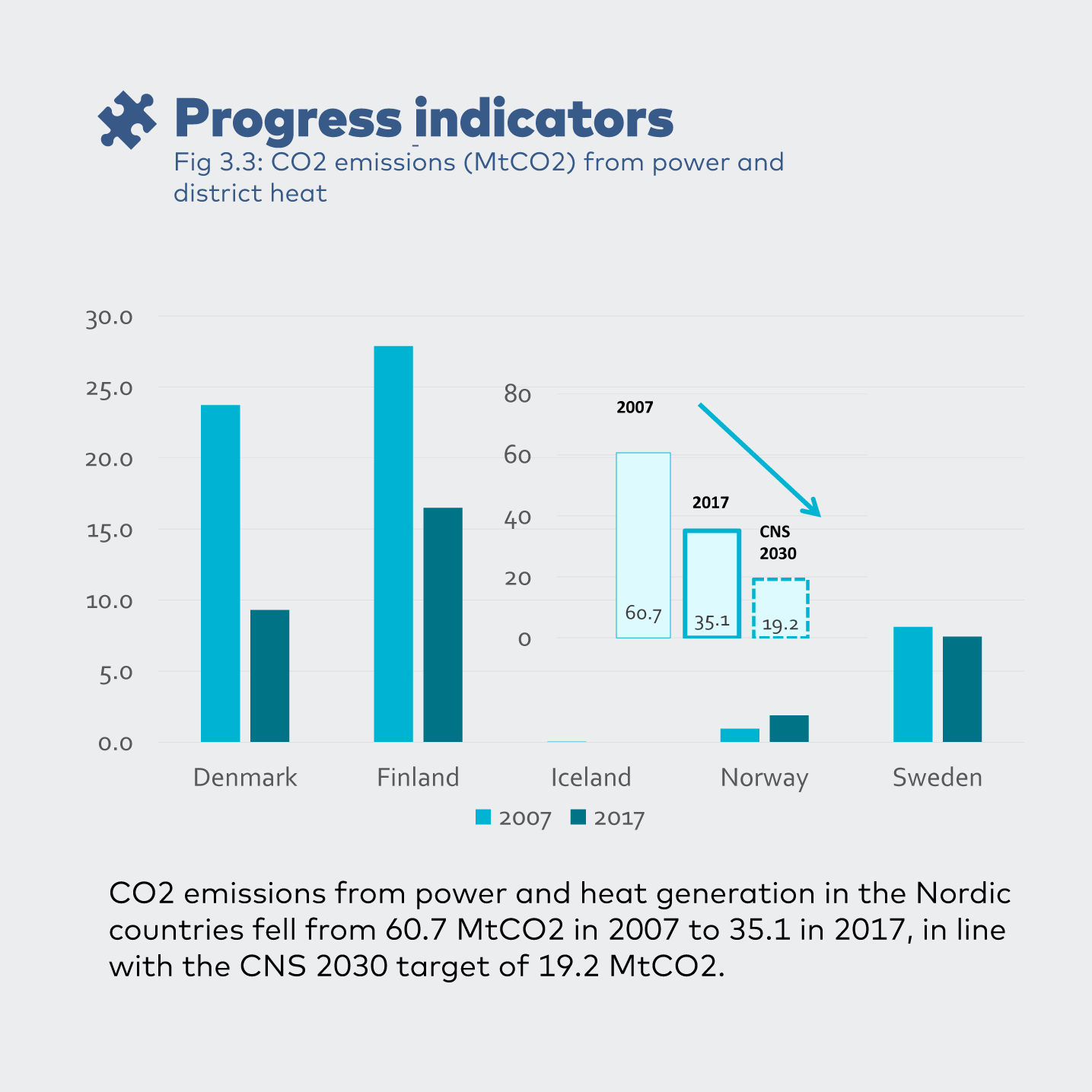
CO2 emissions from power and district heat
Today, Nordic electricity generation is already close to being decarbonised (87% carbon-free) and the Nord Pool area is well suited for integrating wind. However, transformation of the power sector is contingent on continuously improved balancing through a combination of flexible supply, demand response, storage and electricity trading. Read more and download the full report at the Tracking Nordic Clean Energy Progress page

GDP, energy-related CO2 emissions and total primary energy demand
The Nordic region needs to continue to decouple energy-related CO2 from GDP. Progress in industry, transport, and buildings represents the biggest challenge. Energy efficiency and decarbonisation of end-use sectors need to play a prominent role in this decoupling going forward. The total primary energy demand represents the total energy demand in the region and includes: consumption by the energy sector itself, distribution and transformation losses, and final energy consumption by end-users. Note: Total primary energy demand ~ gross inland energy…

Nordic electricity generation and trade, 2017
The Nordic region is the world leader in regional coupling of electricity grids and markets. Interconnectors join countries across land and sea, while a common Nordic spot market ensures efficient trade across subnational price zones. This cooperation increases security of supply, lowers system costs and facilitates the integration of renewables. Thanks to this, the Nordic electricity system is one of the world’s most secure, affordable and renewable. Bidirectional trade flows around Denmark illustrate the role of interconnectors in balancing variable…

Energy mix
Iceland’s vast geothermal energy resources cover most of the country’s heat demand, distributed via district heating. Much of the tapped hydropower potential supplies energy intensive industries – traditionally aluminium smelting, with recent additions of data centres and even bitcoin mining. As Iceland is not connected to the European grid, industrial energy use enables the embodied export of renewable energy as products and services, displacing more carbon-intensive operations elsewhere. Download "10 Insights into the Nordic energy system."

Energy mix
Denmark has little energy intensive industry relative to other Nordic countries. Combined Heat and Power together with district heating provides much of the country’s heat supply, often fired with biomass from agriculture. Wind power alone covered 43% of electricity demand in 2017. Download "10 Insights into the Nordic energy system."
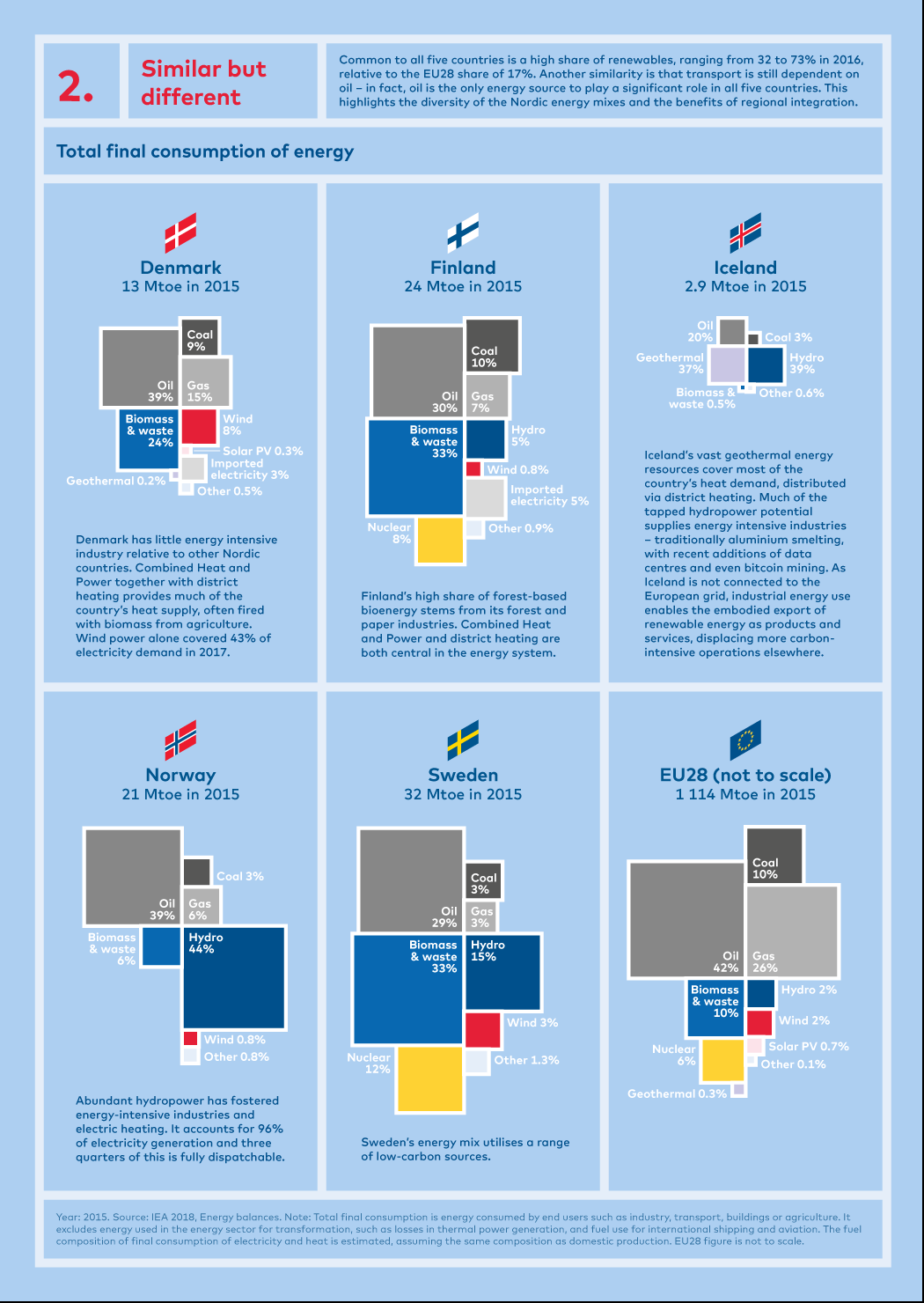
Similar but different
Click the boxes for individual country data. Common to all five countries is a high share of renewables, ranging from 32 to 73% in 2016, relative to the EU28 share of 17%. Another similarity is that transport is still dependent on oil – in fact, oil is the only energy source to play a significant role in all five countries. This highlights the diversity of the Nordic energy mixes and the benefits of regional integration. Download "10 Insights into the…
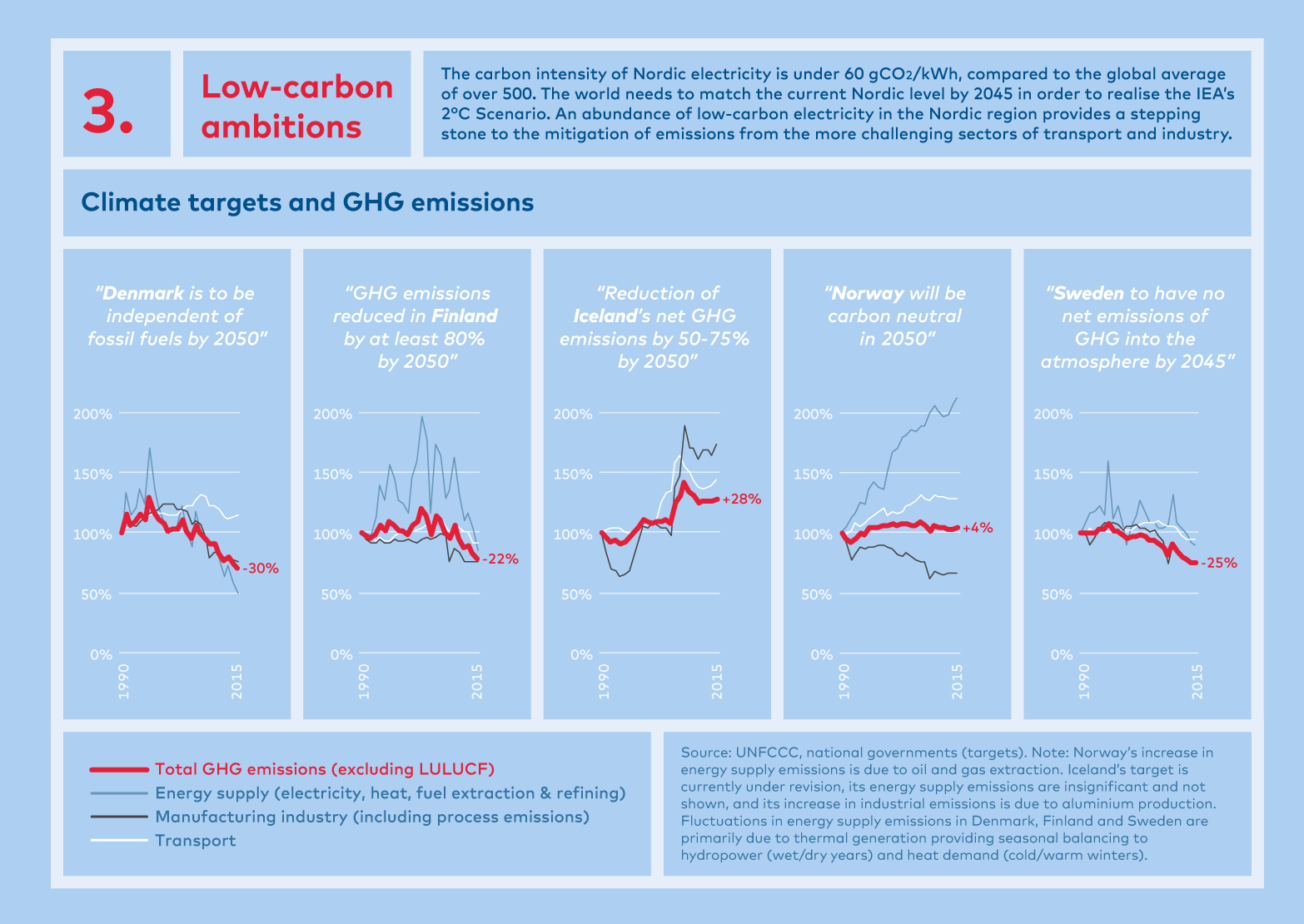
Low-carbon ambitions
The carbon intensity of Nordic electricity is under 60 gCO2/kWh, compared to the global average of over 500. The world needs to match the current Nordic level by 2045 in order to realise the IEA’s 2°C Scenario. An abundance of low-carbon electricity in the Nordic region provides a stepping stone to the mitigation of emissions from the more challenging sectors of transport and industry. Download "10 Insights into the Nordic energy system."

Steady policies
Energy and climate objectives have typically enjoyed broad parliamentary support in the Nordic countries. This has paved the way for steady and long-term energy policies such as carbon taxation, building codes and renewables support, giving clear signals to investors and consumers. Furthermore, the Nordic Council of Ministers facilitates regional cooperation on key policy areas. Sweden offers an example of steady and effective policy, where the district heating supply has been largely decarbonised. Gradually increasing carbon and energy taxes have helped…

Good for the climate and the economy
The Nordic region has decoupled economic growth from GHG emissions faster than the EU28, despite having lower potential for decarbonisation due to its low-carbon heat and power supply. Alternative consumption-based emission accounting (emissions associated with products and services consumed in a country) can reveal if this was accompanied by greater carbon leakage. The figure to the right shows that while the Nordic countries, like most developed countries, have higher consumption-based emissions than territorial emissions, the difference has not changed significantly…

Decarbonising island energy systems
The Faroe Islands are located between Norway and Iceland. Its 50 000 inhabitants have traditionally relied on expensive diesel generators, but plans are afoot to tap local resources in a smart and zero-emission energy system using wind, hydro, solar, tidal, pumped storage and batteries. The Åland Islands rely on imported electricity from Sweden, but look to become a demonstration zone for a 100% renewable energy system. This will be based on distributed generation and flexibility, together with innovative market designs…

Leading the charge on electromobility
Steady policies offering a range of purchase incentives and user benefits have put Norway at the forefront of electric vehicle adoption. Average emissions for new cars in 2017 was 82 gCO2/km, well below the EU target of 95 gCO2/km in 2021. Ferries are ideally suited to electrification due to their relatively short and predictable routes. The Nordic countries have a number of battery electric ferries on the water and under construction, both retrofits and new electric-specific designs. Download "10 Insights…

Flexibility from heat
District heating systems cover the vast majority of residential heating services in Iceland and Denmark, and well over half in Finland and Sweden. District heating is a complementary technology to variable renewables as it is a source of flexibility. Denmark utilises heat alongside flexible thermal generation and electricity trade to integrate wind power equal to 43% of electricity demand in 2017. District heating systems are even capable of long-term storage by using large hot water pits. Download "10 Insights into…
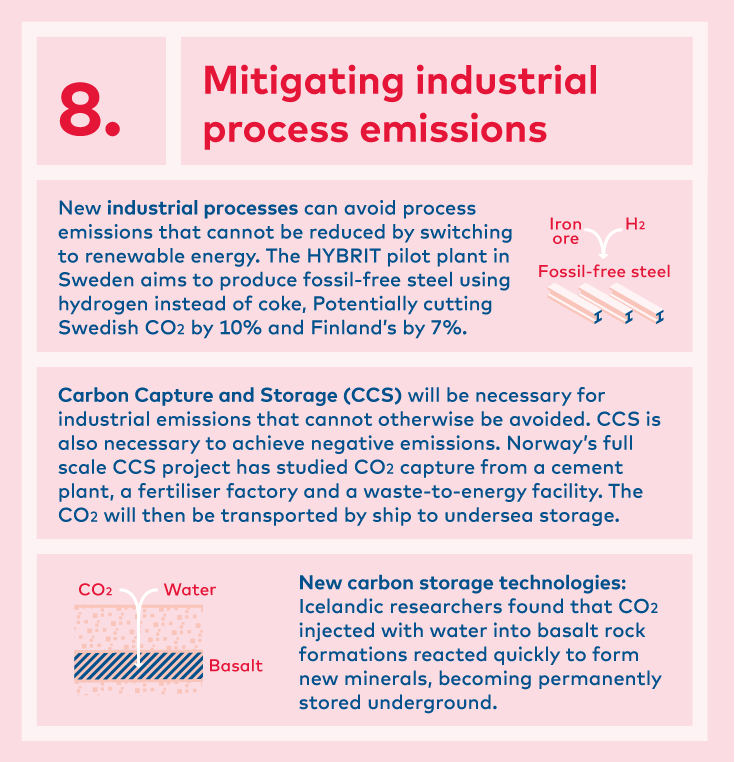
Mitigating industrial process emissions
New industrial processes can avoid process emissions that cannot be reduced by switching to renewable energy. The HYBRIT pilot plant in Sweden aims to produce fossil-free steel using hydrogen instead of coke, Potentially cutting Swedish CO2 by 10% and Finland’s by 7%. Carbon Capture and Storage (CCS) will be necessary for industrial emissions that cannot otherwise be avoided. CCS is also necessary to achieve negative emissions. Norway’s full scale CCS project has studied CO2 capture from a cement plant, a…

The Nordic energy system’s role in Europe
The Nordic region has substantial clean energy resources, especially hydropower and wind. The sustainable utilisation of these resources can contribute to achieving EU climate targets. Firstly, clean power can be exported to displace more emission-intensive generation. In 2017 net Nordic exports were 11 TWh, with Norway exporting 15 TWh and Sweden 20 TWh. This is set to increase with deployment of wind power in the Nordics and a number of transmission cables under construction and planning. Secondly, dispatchable hydropower in…

No net emissions and a focus on transport
By 2050, Sweden will have a sustainable and resource-efficient energy supply and no net emissions of greenhouse gases in the atmosphere. Moreover, the current Swedish government has articulated an ambition to make the vehicle fleet independent of fossil fuel by 2030. Data sources: EEA, the Swedish Government

Carbon-neutral as soon as 2030
Norway’s target is to be carbon-neutral in 2030, if emissions cuts are made by other countries, and by 2050 regardless of international emission cuts. The country’s electricity and heating is largely covered by hydropower, leaving transport and oil and gas extraction and processing as the largest emitters. Norwegian climate policy is based on cost efficiency, meaning a significant portion of the cuts will likely be achieved through offsetting with emissions reductions abroad. Data sources: EEA, the Norwegian Government

Reducing emissions from industry and transport
Iceland has a long term visions of containing reductions of net emission of greenhouse gases by 50% to 75% until the year 2050, using 1990 figures as a baseline. Due to electricity and heat being virtually CO2-free, Icelandic GHG emissions come predominantly from transport and from industrial process emissions. The sharp rises in emissions are due to the addition of new aluminium smelters. Data sources: EEA, the Icelandic Ministry for the Environment
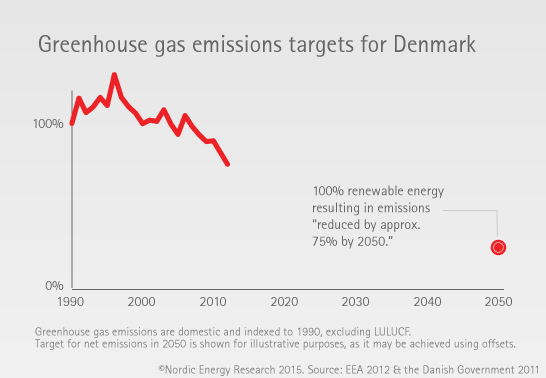
100% renewable energy supply
Denmark has committed to a 100% renewable energy supply by 2050. Calculations made by the Danish Commission on Climate Change Policy show that this would mean Denmark’s greenhouse gas emissions will be reduced by approximately 75% from 1990 levels. Denmark’s long-term goal is supported by a number of ambitious milestones: 50% of electricity supply from wind power in 2020, phasing out coal consumption at power plants by 2030, phasing out oil burners by 2030 and covering all electricity and heat…

Key institutions in the funding of low-carbon energy RD&D in Sweden
Energy policy at the governmental level in Sweden is the responsibility of three Ministries: the Ministry of Enterprise, Energy and Communication, the Ministry of Education and Research and the Ministry of the Environment. Swedish energy research is primarily organised through the Swedish Energy Agency and Vinnova. The Swedish Energy Agency is responsible for Sweden's national energy research programmes. They promote an ecologically and economically sustainable development for Sweden’s energy systems. Vinnova is the innovation funding agency, with an aim to…

Key institutions in the funding of low-carbon energy RD&D in Denmark
Denmark is the only Nordic country to have one ministry for climate and energy. Together with the Danish Energy Agency, it is responsible for renewable energy policy, performance and policy instruments in Denmark. Energy research funding is largely the prerogative of the Council for Strategic Research under the Danish Agency for Science, Technology and Innovation, and the Energy Technology Development and Demonstration Programme (EUDP) under the Danish Energy Agency. In addition, the Danish National Advanced Technology Foundation also funds energy…

Key Nordic institutions for low-carbon energy RD&D funding
The Ministers of Energy for each of the Nordic countries meet annually to discuss energy policy in the region. This cooperation is organised through the Nordic Council of Ministers for Business, Energy and Regional Policy. Policy cooperation is supported by analysis from the Nordic Working Groups. This work if steered by the Committee of Senior Officials for Energy Polices, consisting of representatives from the various national energy agencies and ministries. Nordic research activities are coordinated by Nordic Energy Research. The…
Renewables and nuclear
Sweden has the largest share of renewable energy in the EU. In addition to their extensive use of hydropower, Sweden's forestry resources have made them world-leading in bioenergy for heat and power production. They also have high aspirations for use of bioenergy transportation. Petrol stations of a certain size in Sweden must provide alternative fuels, such as ethanol. This has led to a wide availability of renewable transport fuels, and Sweden now has the largest biofuel-burning fleet of cars in…

An electrified energy system
The Norwegian energy system is unique in that virtually all electricity is generated through hydropower. Unlike other Nordic countries with significant thermal electric and heat production and district heating systems, Norway has electrified its energy system to a much greater extent. Much of space heating is electric, and in recent year a push as been made to introduce electric cars. Like its significant exports of oil, Norway also exports electricity through the Nordic grid, and through goods created in power-intensive…

Tapping vast geothermal resources
81% of Iceland's primary energy is renewable, with the remaining 19% oil used almost exclusively for transportation. As an active volcanic island, geothermal heat is abundant and is Iceland’s main energy source. It accounts for about 90% of space heating, thanks to the country’s extensive district heating system. Icelandic energy consumption is heavily influenced by industry developments. In 2008 the country’s third aluminium smelter began operation. The hydropower plant built to power the facility increased the country’s electricity consumption by…

Bioenergy focus
Finland is one of the industrialised countries to have come furthest in the utilisation of bioenergy, often in Combined Heat and Power (CHP) production. Heat is used in industry and in district heating. There has long been a natural synergy between the forestry, paper and pulp, and energy industry in Finland. Forestry by-products are an important feedstock to the energy industry, while the paper and pulp industry is a significant energy consumer – as well as a producer of energy…

Moving away from oil
The Danish energy supply has seen a marked diversification over the last four decades. This process was accelerated by energy security concerns after the oil crises, leading to a move away from oil to coal, gas and renewables. Recent growth in wind power is evident, but biomass and waste account for a far greater share, being central in power and heat production. Denmark now has the target of becoming completely independent of fossil fuels by 2050, and has successfully de-coupled…
One third renewable, but oil still the largest energy source
Over a third of the Nordic region’s energy supply comes from renewable sources. The largest of these is biomass and waste, which are used to generate electricity, heat and transport fuels in Sweden, Finland and Denmark. Renewable electricity in the region is also generated from hydropower in Norway, as well as growing share of wind power. Geothermal heat and power production is the most important energy source in Iceland. With nuclear power in Sweden and Finland, Over half of the region’s…

Focus on bioenergy, energy efficiency and CCS
Ever since the oil crises, the Nordic countries have prioritised public RD&D in core renewable energy technologies such as energy efficiency, biofuels, solar and wind energy. In the last decade these technologies have seen a considerable surge in support, specifically in biomass in Sweden, Denmark and Finland, energy efficiency in Finland and Norway. In addition, Carbon Capture and Storage has seen significant support in Norway. While Sweden was the prime funder of public low-carbon energy RD&D in the late 70’s…

First-mover after the oil crises, with a renewed focus on bioenergy
Sweden dominated Nordic low-carbon RD&D spending after the oil crises, with a focus on energy efficiency, solar, wind and bioenergy. Among other factors, the lack of a home market due to nuclear expansion prevented this support from fostering a strong export-orientated industrial foothold in these technologies until more recent years. RD&D investments picked up in 2009, thanks to rapid increase in energy efficiency and bioenergy RD&D. For example a funding programme by VINNOVA, miljöinnovationer, started that year. Miljöinnovationer continued until the year…

Significant investment in CCS and efficiency
Norwegian public low-carbon RD&D support has seen a dramatic increase in recent years, beginning in 2004 when the Research Council of Norway’s RENERGI programme started in 2004. Carbon capture and storage (CCS) has seen significant support over the last decade, building on the country’s expertise in oil and gas extraction, and the potential for storage sites in the off the Norwegian coast. The increase in CCS RD&D funding from the mid 2000’s can be explained by the introduction of the…

Steady support for wind power, recent focus on biofuels and H2FC
Denmark has had consistent and prolonged public support of wind energy RD&D. The country was early to establish a home market and now has the world’s highest share of wind in its electricity mix. The Danish wind industry grew to be a large export earner, and is recognised as a global leader in the technology. The reduction in RD&D in the early 2000’s results from a change in government, amongst other factors. Since then investments in low-carbon RD&D have increased…

Biofuel and energy efficiency priority
Finland spends a significant share of GDP on public RD&D, and is known for integrating public and private RD&D activities. The strong support for energy efficiency RD&D is related to the country’s strengths in energy intensive industry, such as paper and pulp. The county is also world leader in bioenergy, and their prioritisation of this field of research is clear in the figure. The steep increase in RD&D funding in 2007 was due to the start of a TEKES-funded programme…
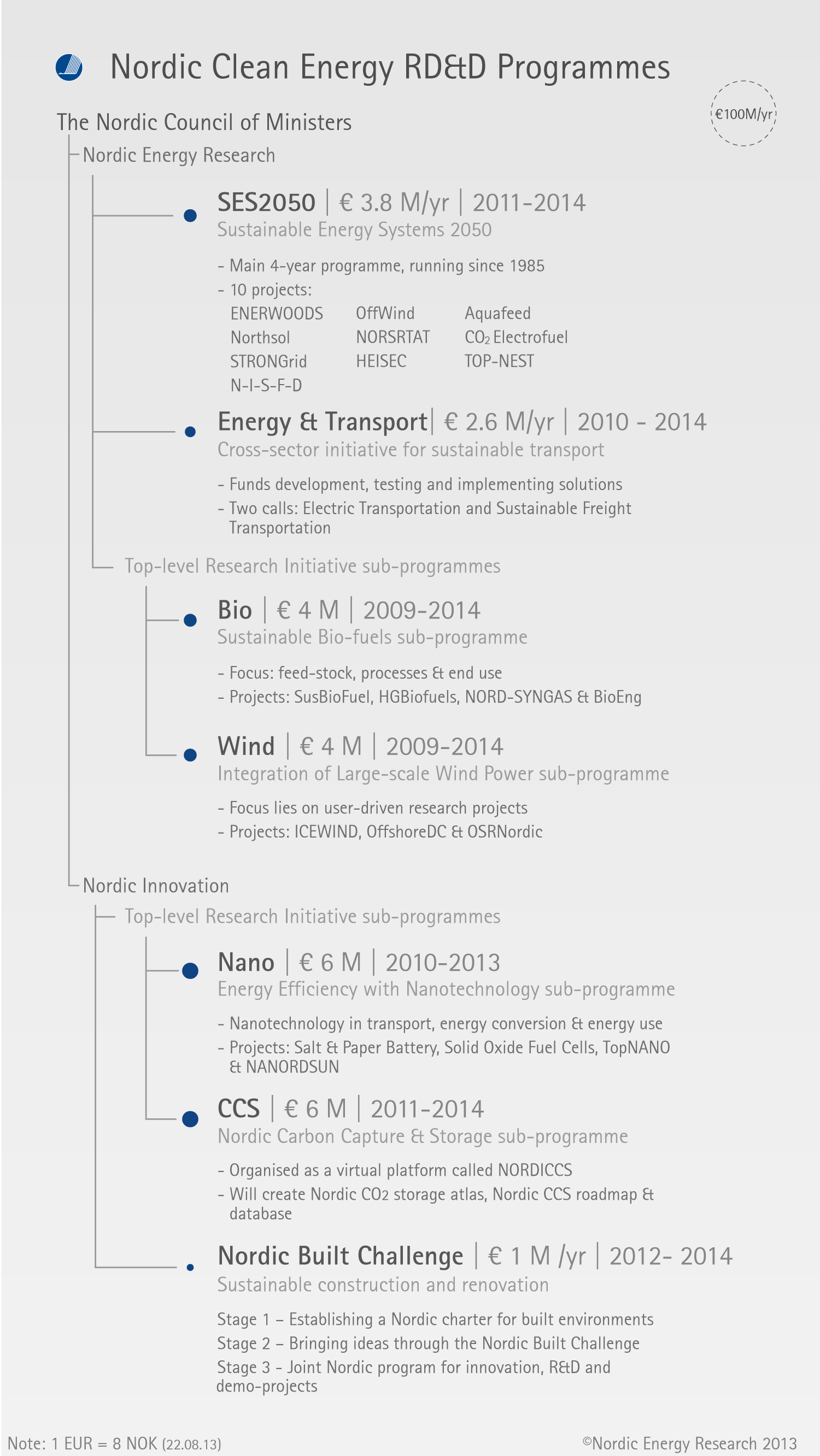
Clean Energy Research Programmes within the Nordic countries
Nordic Energy Research (NER) administers the majority of Nordic RD&D programmes in clean energy topics. NER is funded directly from national energy authorities and from the Nordic Council of Ministers. Through their main programme, Sustainable Energy Systems 2050 (SES2050), 10 projects address a variety of interdisciplinary topics relating to the transition to a sustainable Nordic energy system. The Top-level Research Initiative comprises six-sub programmes, of which four are energy related- NER administers two of the sub-programmes, namely Bio and Wind…
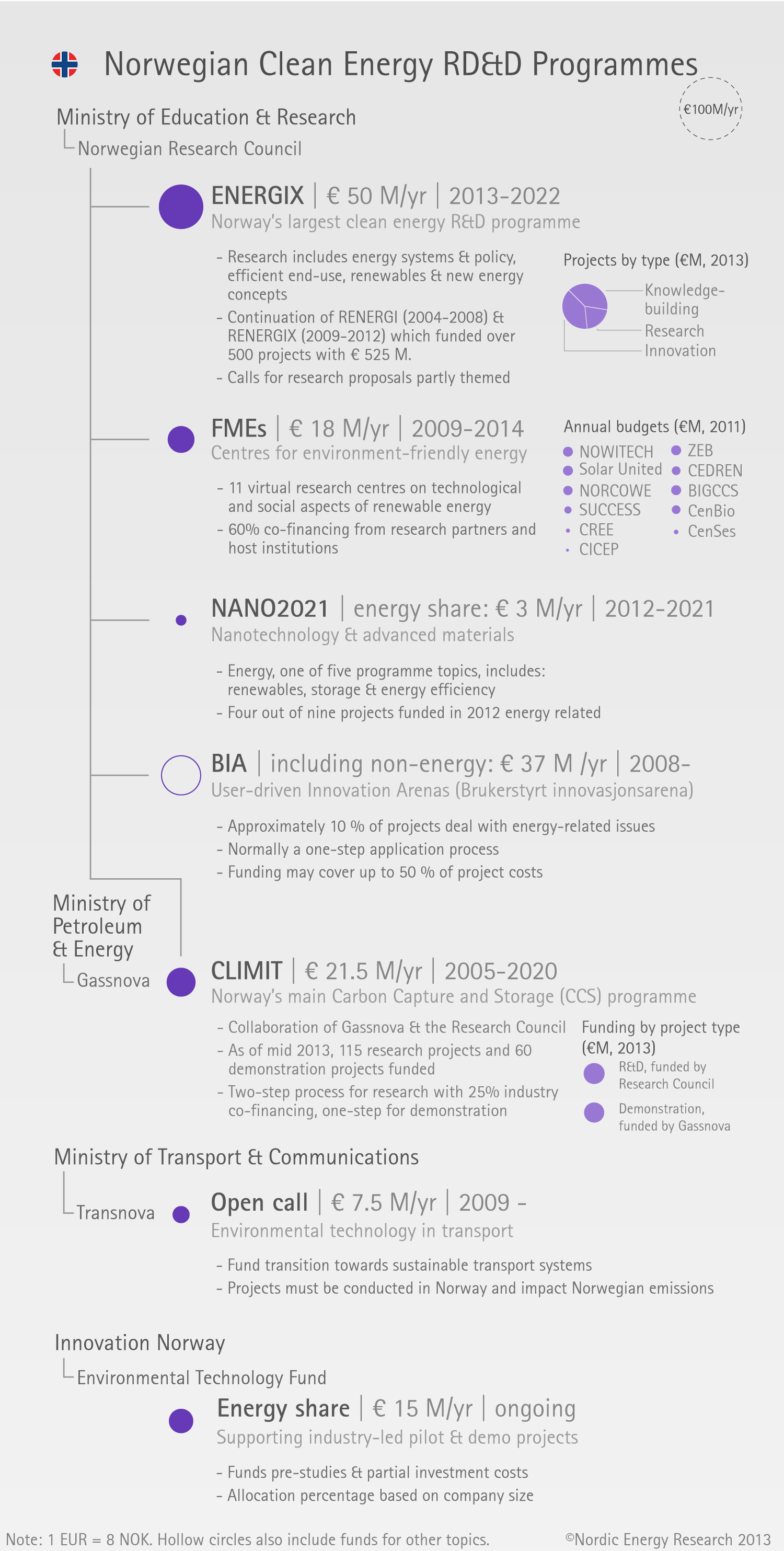
Clean Energy Research Programmes in Norway
In Norway, energy research funds are mainly allocated through the Norwegian Research Council (NRC). From here, funds separate into large programmes, namely ENERGIX, FME, NANO2021 and BIA. ENERGIX, the follow-up of RENERGI, responds to current climate policies in Norway through multi-disciplinary research activities. The € 50 M are announced via themed research proposals that also consider where projects are in the innovation chain. The 11 FME-centres are virtual research clusters, where the focus ranges from solar cell technology, sub-surface CO2…

Clean Energy Research Programmes in Sweden
The Swedish Energy Agency (SEA) distributes the bulk of energy research funds in Sweden, allocating them within six areas to a range of research performers. Energy research is also funded by VINNOVA, the government agency for innovation under the Ministry of Enterprise, Energy & Communications. The Swedish Research Council (SRC), under the Ministry of Research & Education, funds basic research in materials & fusion energy research. In addition, the SRC issues a joint call with the Swedish Energy Agency, whose…

Clean Energy Research Programmes in Finland
The majority of energy research in Finland is allocated by TEKES, the Funding Agency for Technology & Innovation, with € 200 M annually. Within TEKES, there are many energy programs of comparable size, namely Functional Materials, Green Growth, GROOVE, Fuel Cell and EVE. TEKES also runs the Strategic Centres for Science, Technology & Innovation (SHOK) jointly with the Academy of Finland. In addition, the Academy of Finland has funded extensive research on sustainable energy, and although activities terminated in 2012…
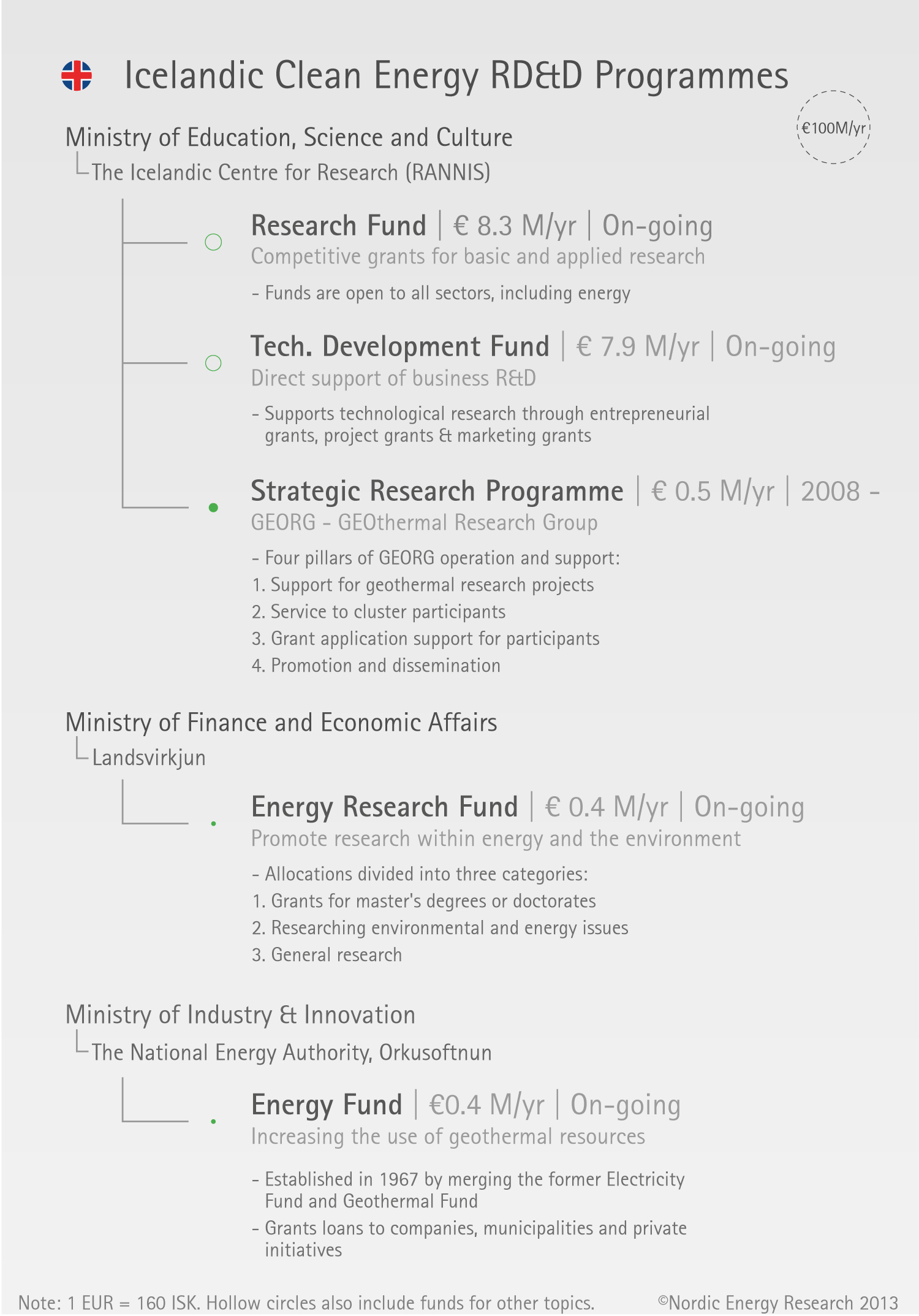
Clean Energy Research Programmes in Iceland
Organised under the Ministry of Finance & Economic Affairs, the Icelandic Research Fund (RANNIS) administers two energy-related funds. The Research Fund allocates € 5 M annually in competitive grants for basic and applied research in a range of topics including energy. The Technology Development Fund allocates € 4.5 M annually in grants for technological research, where energy is also funded. Also formally organised under the same ministry, the Strategic Research Programme runs the Centres of Excellence. GEORG, the geothermal research…

Clean Energy Research Programmes in Denmark
Energy research in Denmark is organised under several ministries and institutions. The Danish Energy Agency funds two research programmes with significant demonstration activities, GreenLabs DK and EUDP. EUDP focuses on new energy technologies, but also allocates special funds for hydrogen, solar and energy efficient transport. GreenLabs DK comprises nine large-scale demo-facilities for new climate technologies. The Danish System Operator, Energinet.dk, funds energy research through national grid tariffs. Although ForskEl & ForskVE both focus on renewable energy production & distribution, ForskVE…

How energy intensive is Nordic GDP?
Given an energy intensity of 0,15ktoe/GDP(mUSD) in the Nordic region, it takes 175 ml of oil-equivalent to earn one U.S. dollar of GDP. The 175 ml represents many diverse energy sources, as 35% of the Nordic energy supply is renewable. Note: Oil-equivalent mass converted to volume as Brent Crude (835kg/m³)

How energy efficient are the Nordic economies?
Energy intensity is a measure of how energy efficient an economy is – it indicates how much energy it takes to create one unit of GDP. In the figure above, an energy intensity of one means that energy equivalent to one thousand tonnes of oil goes towards earning one million dollars in the economy. Energy intensity reduces as energy efficiency in demand sectors like buildings and industry increases, but the overall structure economy also influences the ratio. Countries with significant…

Increasingly energy efficient economies
Over the last 20 years, the major economies have gradually reduced their energy intensities. That is to say that they now use less energy to produce one unit of GDP than they did before. The only exception in the figure above is the specific case of Iceland. The trend towards efficiency is most evident in China. As its economy has increased productivity and moved towards higher value products, GDP has increased much faster than energy consumption. The trend also reflects…
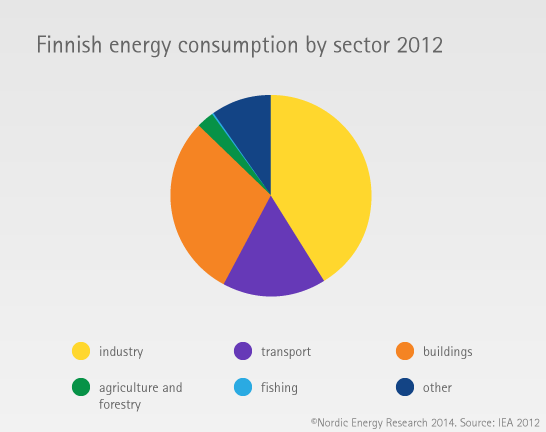
Finnish energy consumption by sector
Finland used 1 117 PJ of energy in 2010, accounting for about a quarter of the energy used in the Nordic countries. 41% of energy is used in industry – a higher share than all other Nordic countries except Iceland. This is due to the important role of paper, pulp and other energy-intensive industries in the Finnish economy. With the exception of Iceland, Finland has the highest energy consumption per capita of the Nordic countries. The country is however a world leader in industrial ecology…

Norwegian energy consumption by sector
Norway used 896 PJ of energy in 2010, which accounts for 21% of the energy used in the Nordic region. Due to the high volume of electricity consumption by the aluminium industry and in space and water heating in buildings, Norway is second only to Iceland in electricity consumption per capita. Electricity produced in Norway however is almost entirely renewable, based on significant hydroelectric resources. Transport accounts for a significant share of energy use in Norway, due to a population…

Danish energy used mostly in buildings
Denmark consumed 627 PJ of energy in total in 2010, accounting for about 15% of energy use in the Nordic countries. Almost half of all energy in Denmark is spent in buildings, two-thirds of which is used in residential buildings. Compared to its Nordic neighbours, Denmark has relatively little energy-intensive industry. This is due in part to the country's lack of access to cheap energy resources, and results in very low energy consumption per capita. Denmark is also a pioneer…
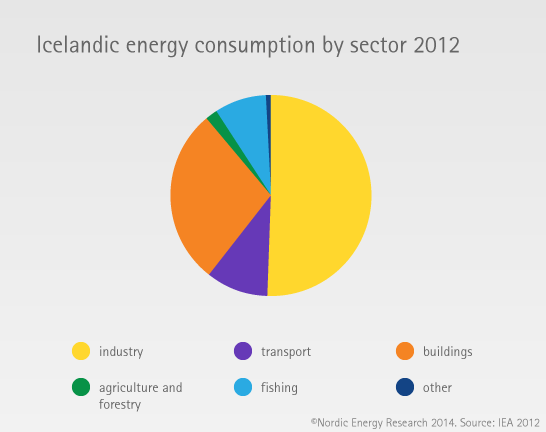
Over 50% of energy in Iceland used in industry
Iceland used 123 PJ of energy in 2010, which accounts for just 3% of energy use in the Nordic countries. Around half of Iceland’s energy is used in the industrial sector, most of which can be attributed to metal manufacturing. Due to the high volume of electricity consumption by the aluminium industry, and the country's population of just 320,000, Iceland has the world’s highest electricity consumption per capita. Fishing has a much more prominent role in the Icelandic economy and…
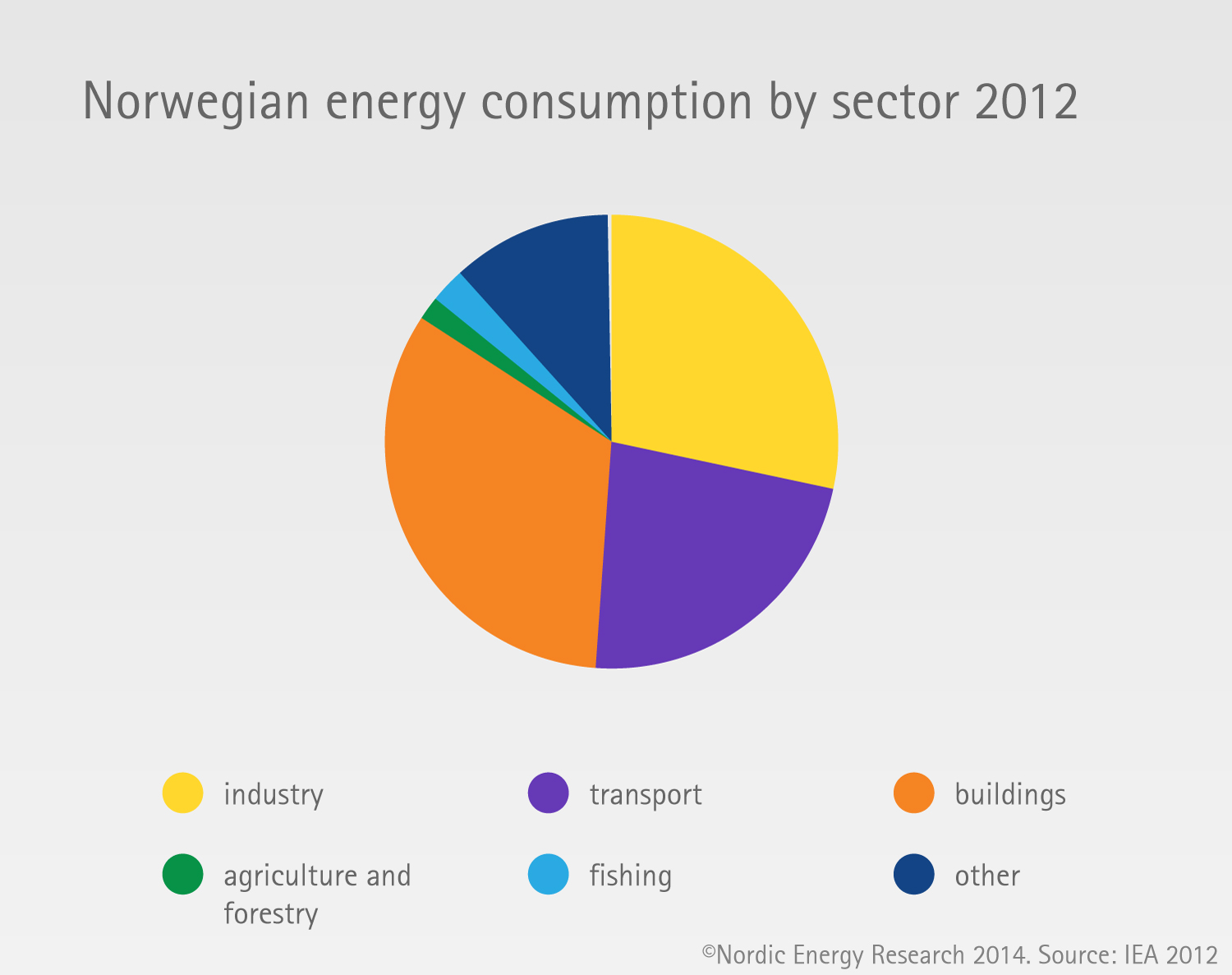
Energy consumption by sector
The total energy consumption in the Nordic countries was 4 237 PJ in 2010, which is equal to about 8% of energy consumption in the EU-27. Industry accounts for about a third of energy use in the Nordic countries on average, considerably higher than most other developing countries. Large hydroelectric potential and a rich endowment of raw materials such as wood and minerals have played an important role in the development of energy-intensive industry in the region
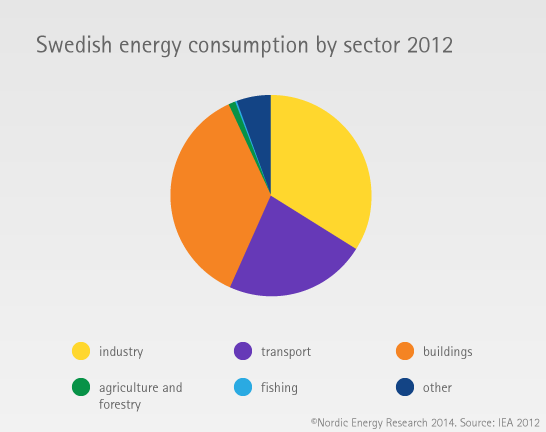
Swedish energy used mostly in industry and buildings
Sweden used 1 475 PJ of energy in total in 2010, accounting for a bit over a third of energy use in the Nordic countries. Swedish energy use resembles that of the Nordic average, with about a third each used in industry and buildings, and 29% of energy used in transport. Sweden's energy intensive industries cover paper and pulp, as well as steel manufacturing. The energy supply of Sweden saw its carbon intensity drop dramatically in the late 70s and…

Greenhouse gas emissions per capita
Despite having a relatively decarbonised electricity supply, the Nordic region has slightly higher per capita Greenhouse Gas (GHG) emissions than other industrialised countries in Europe and Asia. This is due in part to the cold climate and prevalence of energy-intensive industry. The Nordic countries have set ambitious targets for emissions reductions by 2050. Danish emissions are influenced by its relatively carbon-intensive electricity production compared to other countries, but counteracted by its lack of energy-intensive industry. Denmark has been among the…

How much energy does a Nordic citizen use?
There are considerable differences in energy use per capita in the Nordic region. While all five countries share a relatively cold climate, variation in industrial activity and energy resources result in significant differences in energy and electricity use per capita. Both Iceland and Norway have electricity-intensive industries, taking advantage of abundant renewable sources of electricity in the two countries, such as geothermal and hydropower. Norway uses electricity in the heating of space and water to a much larger extent than the other…

Key institutions in the funding of low-carbon energy RD&D in Norway
Energy issues in Norway are addressed by the Ministry of Petroleum and Energy and a number of agencies under the Ministry. Enova was established in 2001 to promote more efficient energy use and increased implementation of renewable energy. Gassnova ensures the implementation of the government’s interests in the area of Carbon Capture and Storage (CCS), while Transnova works with reducing emissions from the transportation sector. The Norwegian Water Resources and Energy Directorate (NVE) is responsible for the administration of Norway's…
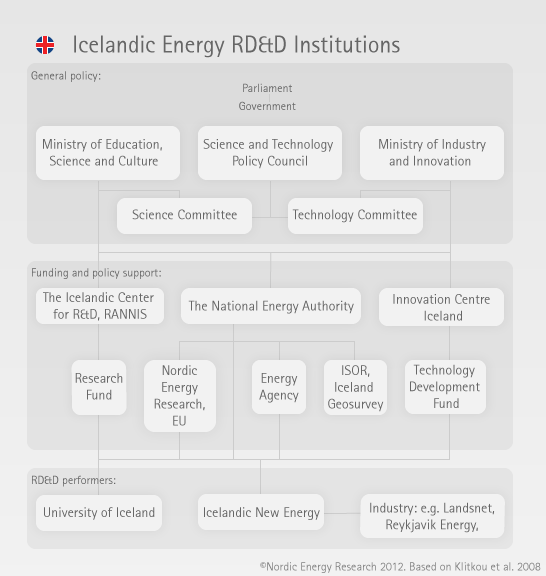
Key institutions in the funding of low-carbon energy RD&D in Iceland
In Iceland, energy issues are placed under the Ministry of Industry, Energy and Tourism. The government agencies responsible for the energy area are Orkustofnun (the Icelandic National Energy Authority) and Orkusetur (the Energy Agency). The National Energy Authority, Orkustofnun, focuses on energy research, monitoring of energy resources and knowledge sharing internationally – especially within geothermal technologies. Orkusetur, Iceland’s Energy Agency, promotes energy efficiency in households and industry. and a reduction in the use of fossil fuels for transportation. Energy R&D…

Key institutions in the funding of low-carbon energy RD&D in Finland
In Finland, energy issues are largely placed under the Ministry of Employment and the Economy. The Ministry promotes environmental technologies, and has a key role in the formulation of innovation policy. The Ministry of the Environment is also involved in regulatory matters and in developing guidelines for energy efficiency. Under the Ministry of Employment and the Economy, Tekes (The Finnish Funding Agency for Technology and Innovation) is responsible for energy innovation and technology development. They administrate several SHOKs (Strategic Centres…

Danish leadership in decoupling economic growth
Denmark has had a more pronounced decoupling of GDP from greenhouse gas emissions than the Nordic region as a whole. Denmark is unique in its commitment to a reduction of both emissions and energy consumption, and to become independent of fossil fuels. By focusing on energy efficiency, the country has managed to reduce energy consumption while the economy has grown by almost 80% in the last 30 years. One factor in the gradual decoupling of energy use from greenhouse gas…

World’s highest share of wind power
Denmark is well known for its successful integration of wind power. The share of wind has risen steadily over the last decades and and Denmark now has the world’s highest share of wind in it’s electricity mix. Combined with biomass, a quarter of the country’s electricity production is renewable. The home-market for wind turbines, combined with supportive policies and R&D support, has helped Denmark become a world leader in wind power technology. Coal still accounts for almost half of electricity…
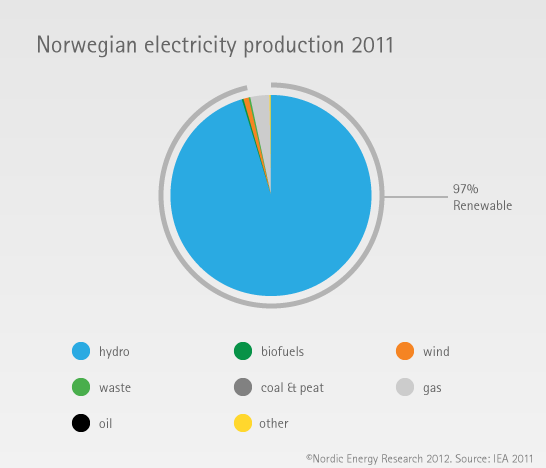
Hydroelectric battery of the north
Norwegian electricity production is dominated by hydropower. Hydropower is one of the only renewable energy sources that can be stored, and the generators can easily regulate output from one minute to the other. Thanks to the common Nordic grid, Norway's large reservoir capacity can be used to store and regulate a fluctuating supply from renewable energy sources like wind and solar in neighbouring countries. Norway also has significant untapped wind and bioenergy resources, which could prove useful for future domestic…

Highly diversified sources
Hydropower and biomass are the key contributors to the renewable 30% of Finland’s electricity supply. Biomass has long been an important part of Finnish electricity and heat production, thanks to its forestry sector. Nuclear is the largest single source, and combined with renewables, almost two thirds of the electricity produced in Finland is CO2-free. Data source: IEA
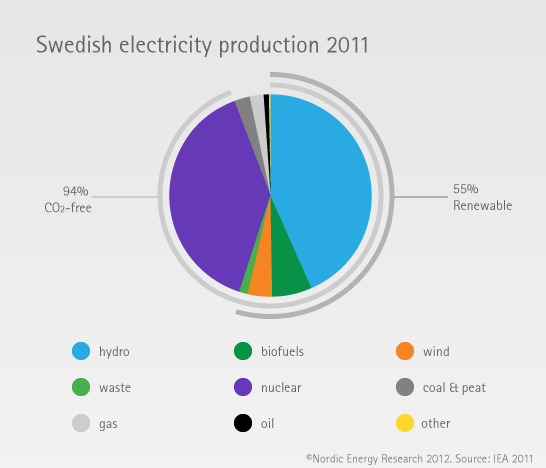
96% CO2-free electricity
Swedish electricity production is 58% renewable thanks to significant hydropower production, and biomass-fired combined heat and power production. Wind power has seen a significant increase in capacity in recent years, and is expected to take a larger share of production in the future. Adding Sweden’s substantial nuclear generation to the renewable power means 96% of Sweden’s electricity production is CO2-free. Data source: IEA

World’s highest share of geothermal power
Unlike the other countries in the Nordic region, Iceland's electricity grid is isolated. Most small island economies rely on oil-fired power plants to provide steady electricity supply, but Iceland has virtually 100% renewable electricity from its abundant hydropower and geothermal resources. Significant geothermal, hydropower and wind resources are left unutilised due to the low demand of the country’s 320 000 inhabitants, and their inability to export the electricity directly. Instead, the energy is exported through power-intensive industries such as aluminium…

Major net exporter of fossil fuels
The Nordic region is a significant net energy exporter. This is due to considerable oil and natural gas extraction in Norway, almost all of which is exported. Norway is the world’s 5th largest oil exporter and 3rd largest natural gas exporter. Domestic demand for oil and gas in Norway is limited by the population of only 5 million, as well as high taxes on oil products and a moratorium on new natural gas power plants without CCS technology. Finland, Sweden…

Two-thirds renewable
Nordic electricity production is two thirds renewable. This is due to the large amount of hydropower in Norway, and Sweden, but also to growing sources of other renewables. Biomass is burned in Combined Heat and Power plants across Finland and Sweden, while Denmark has the highest share of wind power in the world. Iceland generates significant electricity from geothermal sources. In addition to renewables, nuclear power in Sweden and Finland means that the region’s electricity if 85% CO2-free. Individually, the…

Renewable shares above average
At almost two thirds, the Nordic region has one of the highest shares of renewable electricity consumption in the world. All five Nordic countries sit above the EU27 average, with Iceland and Norway having close to 100% renewable electricity consumption. Notes: Electricity consumption should not be confused with electricity production. Data sources: Eurostat 2010 (Nordic, Norway, Sweden, Finland and Denmark), EEA 2009 (world), Orkustofnun 2010 (Iceland)
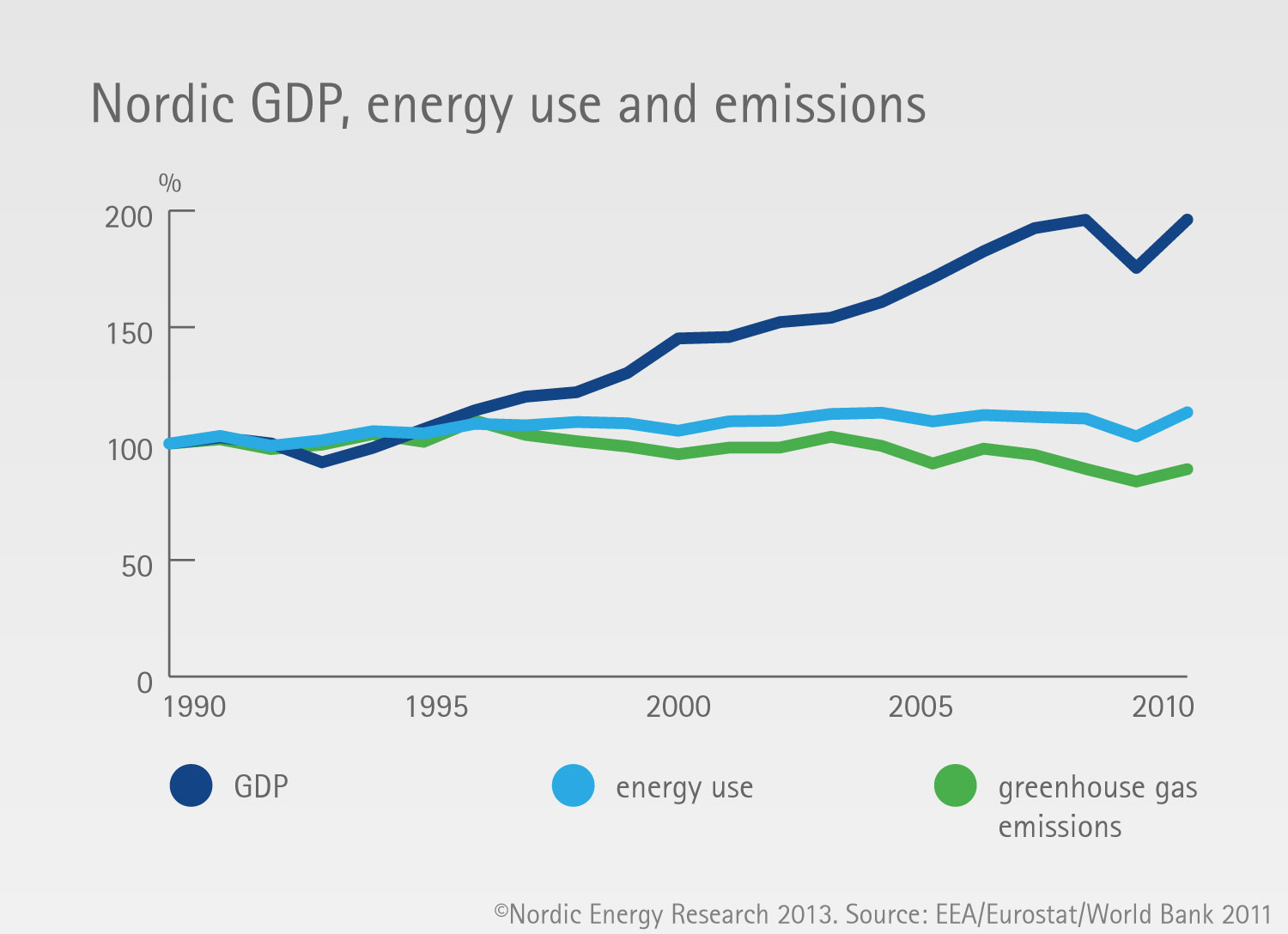
Decoupling economic growth
The Nordic region has successfully decoupled growth in GDP from greenhouse gas emissions in the last decade. Decoupling economic growth from environmental damage has been widely advocated as a key step towards sustainability. This can also be described as a reduction in the energy intensity of the Nordic economies, a measure of the energy used to create one unit of GDP. It is important however, to consider the effect of ‘carbon leakage’ – where carbon-intensive industry moves outside the region. This…

